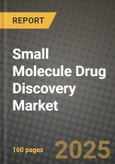The small molecule drug discovery market continues to be a cornerstone of pharmaceutical innovation, accounting for a substantial share of new therapeutic development across disease categories. Small molecules are chemically synthesized compounds with low molecular weight that interact with specific biological targets to modulate disease pathways. Their oral bioavailability, cost-effective manufacturing, and well-established regulatory frameworks make them highly attractive to both large pharmaceutical companies and emerging biotech firms. From oncology and infectious diseases to neurological and metabolic disorders, small molecules have remained central to global R&D pipelines. Recent scientific advancements, such as fragment-based drug design, structure-based drug design, and artificial intelligence (AI)-enabled screening, have accelerated discovery timelines and improved the probability of success. As the need for precision medicine grows and the industry shifts toward faster, more targeted drug development, small molecule discovery remains a critical area of investment. The market is supported by a strong ecosystem of contract research organizations (CROs), academic collaborations, and digital drug discovery platforms, all of which contribute to greater flexibility, scalability, and innovation across the drug development lifecycle.
The small molecule drug discovery market was marked by rapid digital transformation and cross-disciplinary partnerships. AI and machine learning tools were increasingly integrated into early-phase discovery to predict compound behavior, prioritize lead candidates, and model binding affinities. Pharmaceutical companies deepened their collaborations with tech firms and academic research institutions to enhance data-driven compound screening. Meanwhile, fragment-based and phenotypic screening approaches gained traction, offering alternative paths to identify novel hits where traditional target-based screening fell short. In oncology and immunology, companies focused on discovering small molecules capable of modulating previously “undruggable” targets, such as transcription factors and protein-protein interactions. The rising demand for targeted therapies and orphan drugs further spurred investment in niche small molecule programs. Additionally, drug repurposing strategies continued to gain momentum, allowing developers to leverage existing compounds to fast-track approvals in new indications. The convergence of computational tools, automation, and structural biology reshaped how discovery campaigns were conducted, enabling greater throughput with reduced resource expenditure.
The small molecule drug discovery market is expected to undergo deeper integration of AI, quantum computing, and cloud-based platforms. These technologies will further accelerate hit-to-lead optimization, allow for more precise prediction of pharmacokinetics, and reduce attrition rates during development. Additionally, the emergence of covalent inhibitors and targeted protein degraders is poised to open new frontiers in therapeutic intervention, particularly for complex diseases with few treatment options. Global regulatory bodies are anticipated to refine accelerated approval pathways for novel small molecules addressing unmet medical needs, offering incentives for innovation and faster access to patients. The increasing outsourcing of discovery programs to specialized CROs and biotech partners will enable smaller firms to participate in high-value pipelines without heavy infrastructure investment. As the industry faces rising costs and talent shortages, automation and robotics will play a growing role in streamlining lab operations and data generation. Ultimately, companies that adopt a data-first approach and leverage collaborative ecosystems will be best positioned to drive success in this highly competitive and scientifically demanding market.
Key Insights: Small Molecule Drug Discovery Market
- Adoption of AI-Driven Screening: Machine learning algorithms are increasingly used to analyze compound libraries, predict drug-likeness, and identify promising leads, significantly speeding up early-phase drug discovery and improving cost-efficiency.
- Rise of Targeted Protein Degraders: Innovative small molecules like PROTACs (proteolysis-targeting chimeras) are gaining traction for their ability to degrade disease-causing proteins, especially those previously considered undruggable.
- Expansion of Phenotypic Screening Methods: There is renewed interest in phenotypic assays that evaluate compound effects on cellular systems without requiring a predefined target, allowing broader exploration of therapeutic pathways.
- Growth of Drug Repurposing Initiatives: Researchers are increasingly revisiting shelved or approved drugs to identify new therapeutic uses, reducing discovery timelines and improving success rates in clinical trials.
- Integration of Quantum Computing in Modeling: Quantum simulations are being explored for molecular modeling, potentially revolutionizing how researchers predict molecular interactions and chemical properties in the drug design phase.
- High Prevalence of Chronic and Rare Diseases: Rising incidence of cancer, neurological disorders, and rare diseases continues to fuel the need for innovative small molecule therapies that can be administered easily and affordably.
- Supportive Regulatory Environment: Expedited review programs and orphan drug designations offered by agencies like the FDA and EMA are encouraging investment in novel small molecule discovery projects.
- Advancements in Structural Biology: Improved techniques like cryo-EM and NMR spectroscopy are enabling more accurate visualization of molecular targets, informing better structure-based drug design approaches.
- Increased R&D Outsourcing: Drug developers are turning to CROs and biotech partners for specialized discovery services, benefiting from access to expertise, infrastructure, and cost-effective operations.
- High Attrition Rates in Development: Despite advances in screening and modeling, a significant number of small molecule candidates still fail during later-stage trials due to poor efficacy or unforeseen toxicity, resulting in high R&D costs and delayed market entry.
Small Molecule Drug Discovery Market Segmentation
By Drug Type
- Small Molecule Drugs
- Biologic Drugs
By Technology
- High Throughput Screening
- Pharmacogenomics
- Combinatorial Chemistry
- Nanotechnology
- Others
By Therapeutic Area
- Oncology
- Central Nervous System
- Cardiovascular
- Respiratory
- Metabolic Disorders
- Gastrointestinal
- Others
By Process/Phase
- Target ID Or Validation
- Hit Generation and Selection
- Lead Identification
- Lead Optimization
By End-User
- Pharmaceutical Companies
- Contract Research Organizations
- Others
Key Companies Analysed
- Pfizer Inc.
- GlaxoSmithKline plc
- AstraZeneca
- Boehringer Ingelheim International GmbH
- Bristol-Myers Squibb Company
- Johnson & Johnson
- Gilead Sciences Inc.
- Merck KGaA
- Novartis AG
- 21st Century Therapeutics Inc.
- 4SC AG
- Teva Pharmaceutical Industries Ltd.
- Takeda Pharmaceutical Company Limited
- Immunocure Inc.
- Labcorp Drug Development
- ICON Public Limited Company
- Charles River Laboratories
- Aluda Pharmaceuticals
- CelerisTx
- Clinuvel Pharmaceuticals
- Corcept Therapeutics
- Doloromics
- Edison Oncology
- Escend Pharmaceuticals
- Terray Therapeutics
- Apollomics
- Astex Pharmaceuticals
- Surface Ophthalmics
- Pardes Biosciences
- Xynomic Pharmaceuticals
- AfaSci
- Zevra Therapeutics
- Saniona
- UNION therapeutics
- Tetra Pharm Technologies
- Pharmacosmos
- Allarity Therapeutics
- Xellia Pharmaceuticals
- Cyteir Therapeutics
- BigHat Biosciences.
Small Molecule Drug Discovery Market Analytics
The report employs rigorous tools, including Porter’s Five Forces, value chain mapping, and scenario-based modeling, to assess supply-demand dynamics. Cross-sector influences from parent, derived, and substitute markets are evaluated to identify risks and opportunities. Trade and pricing analytics provide an up-to-date view of international flows, including leading exporters, importers, and regional price trends.Macroeconomic indicators, policy frameworks such as carbon pricing and energy security strategies, and evolving consumer behavior are considered in forecasting scenarios. Recent deal flows, partnerships, and technology innovations are incorporated to assess their impact on future market performance.
Small Molecule Drug Discovery Market Competitive Intelligence
The competitive landscape is mapped through proprietary frameworks, profiling leading companies with details on business models, product portfolios, financial performance, and strategic initiatives. Key developments such as mergers & acquisitions, technology collaborations, investment inflows, and regional expansions are analyzed for their competitive impact. The report also identifies emerging players and innovative startups contributing to market disruption.Regional insights highlight the most promising investment destinations, regulatory landscapes, and evolving partnerships across energy and industrial corridors.
Countries Covered
- North America - Small Molecule Drug Discovery market data and outlook to 2034
- United States
- Canada
- Mexico
- Europe - Small Molecule Drug Discovery market data and outlook to 2034
- Germany
- United Kingdom
- France
- Italy
- Spain
- BeNeLux
- Russia
- Sweden
- Asia-Pacific - Small Molecule Drug Discovery market data and outlook to 2034
- China
- Japan
- India
- South Korea
- Australia
- Indonesia
- Malaysia
- Vietnam
- Middle East and Africa - Small Molecule Drug Discovery market data and outlook to 2034
- Saudi Arabia
- South Africa
- Iran
- UAE
- Egypt
- South and Central America - Small Molecule Drug Discovery market data and outlook to 2034
- Brazil
- Argentina
- Chile
- Peru
Research Methodology
This study combines primary inputs from industry experts across the Small Molecule Drug Discovery value chain with secondary data from associations, government publications, trade databases, and company disclosures. Proprietary modeling techniques, including data triangulation, statistical correlation, and scenario planning, are applied to deliver reliable market sizing and forecasting.Key Questions Addressed
- What is the current and forecast market size of the Small Molecule Drug Discovery industry at global, regional, and country levels?
- Which types, applications, and technologies present the highest growth potential?
- How are supply chains adapting to geopolitical and economic shocks?
- What role do policy frameworks, trade flows, and sustainability targets play in shaping demand?
- Who are the leading players, and how are their strategies evolving in the face of global uncertainty?
- Which regional “hotspots” and customer segments will outpace the market, and what go-to-market and partnership models best support entry and expansion?
- Where are the most investable opportunities - across technology roadmaps, sustainability-linked innovation, and M&A - and what is the best segment to invest over the next 3-5 years?
Your Key Takeaways from the Small Molecule Drug Discovery Market Report
- Global Small Molecule Drug Discovery market size and growth projections (CAGR), 2024-2034
- Impact of Russia-Ukraine, Israel-Palestine, and Hamas conflicts on Small Molecule Drug Discovery trade, costs, and supply chains
- Small Molecule Drug Discovery market size, share, and outlook across 5 regions and 27 countries, 2023-2034
- Small Molecule Drug Discovery market size, CAGR, and market share of key products, applications, and end-user verticals, 2023-2034
- Short- and long-term Small Molecule Drug Discovery market trends, drivers, restraints, and opportunities
- Porter’s Five Forces analysis, technological developments, and Small Molecule Drug Discovery supply chain analysis
- Small Molecule Drug Discovery trade analysis, Small Molecule Drug Discovery market price analysis, and Small Molecule Drug Discovery supply/demand dynamics
- Profiles of 5 leading companies - overview, key strategies, financials, and products
- Latest Small Molecule Drug Discovery market news and developments
Additional Support
With the purchase of this report, you will receive:- An updated PDF report and an MS Excel data workbook containing all market tables and figures for easy analysis.
- 7-day post-sale analyst support for clarifications and in-scope supplementary data, ensuring the deliverable aligns precisely with your requirements.
- Complimentary report update to incorporate the latest available data and the impact of recent market developments.
This product will be delivered within 1-3 business days.
Table of Contents
Companies Mentioned
- Pfizer Inc.
- GlaxoSmithKline PLC
- AstraZeneca
- Boehringer Ingelheim International GmbH
- Bristol-Myers Squibb Company
- Johnson & Johnson
- Gilead Sciences Inc.
- Merck KGaA
- Novartis AG
- 21st Century Therapeutics Inc.
- 4SC AG
- Teva Pharmaceutical Industries Ltd.
- Takeda Pharmaceutical Company Limited
- Immunocure Inc.
- Labcorp Drug Development
- ICON Public Limited Company
- Charles River Laboratories
- Aluda Pharmaceuticals
- CelerisTx
- Clinuvel Pharmaceuticals
- Corcept Therapeutics
- Doloromics
- Edison Oncology
- Escend Pharmaceuticals
- Terray Therapeutics
- Apollomics
- Astex Pharmaceuticals
- Surface Ophthalmics
- Pardes Biosciences
- Xynomic Pharmaceuticals
- AfaSci
- Zevra Therapeutics
- Saniona
- UNION therapeutics
- Tetra Pharm Technologies
- Pharmacosmos
- Allarity Therapeutics
- Xellia Pharmaceuticals
- Cyteir Therapeutics
- BigHat Biosciences .
Table Information
| Report Attribute | Details |
|---|---|
| No. of Pages | 160 |
| Published | October 2025 |
| Forecast Period | 2025 - 2034 |
| Estimated Market Value ( USD | $ 57.7 Billion |
| Forecasted Market Value ( USD | $ 119.2 Billion |
| Compound Annual Growth Rate | 8.4% |
| Regions Covered | Global |
| No. of Companies Mentioned | 40 |









